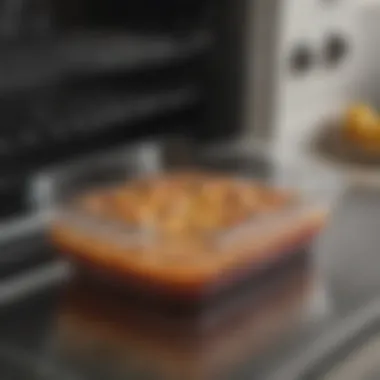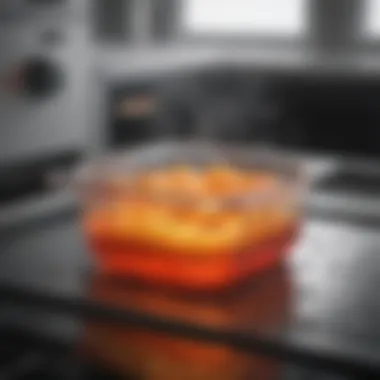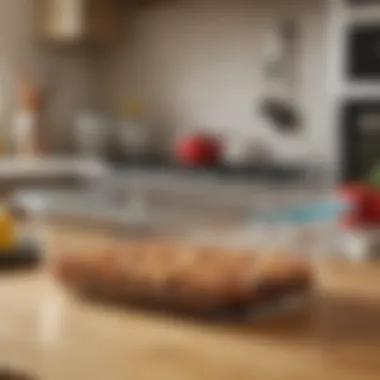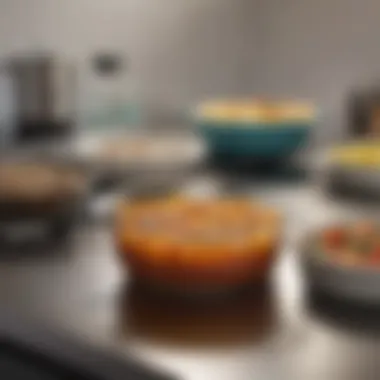Is Pyrex Oven Safe? A Comprehensive Examination


Intro
In kitchens around the world, Pyrex glassware has secured a reputation for versatility and reliability. Many home cooks and culinary enthusiasts rely on it for various cooking needs, including baking, roasting, and meal prep. Yet, doubts persist regarding its performance in extreme temperatures, particularly in oven settings. This section serves as an introduction to the complexities surrounding Pyrex and its suitability for oven use.
Understanding its materials, properties, and behavior under heat is crucial for ensuring not only the integrity of the glass but also safety when preparing meals. This article aims to clarify these points, exploring both the science behind Pyrex and practical advice for users.
With increasingly diverse cooking methods and innovations in kitchen tools, assessing the safety of using Pyrex in an oven is more relevant now than before. Many consumers seek reassurance, and a comprehensive examination is essential to guide them accurately.
Intro to Pyrex
Pyrex is not just a name; it is synonymous with durability, safety, and versatile cooking solutions in kitchens around the world. Understanding Pyrex is essential, as it has carved out a significant niche in both everyday cooking and specialized culinary uses. The glass cookware is often praised for its ability to withstand high temperatures and deliver consistent performance. This section will focus on its origins, the materials that make it distinct, and the unique features that set it apart from other cooking vessels.
History of Pyrex
The Pyrex brand has a storied history that dates back to the early 20th century. Originally developed in 1915 by Corning Glass Works, Pyrex was designed to withstand thermal shock, which allows it to shift from hot to cold environments without breaking. The product quickly gained popularity due to its practicality and reliability. This was particularly appealing to homemakers before World War II.
Over the decades, innovations and refinements to the manufacturing process have allowed for a wider range of products, including measuring cups and baking dishes. The introduction of colorful designs further cemented Pyrex’s appeal. Today, it remains a beloved brand, recognized for quality and safety. From pie plates to casserole dishes, Pyrex offers a variety of shapes and sizes for every cooking need.
Materials Used in Pyrex
Understanding the materials that comprise Pyrex is crucial for evaluating its safety in oven use. The composition affects heat resistance, durability, and how the cookware performs under varying temperatures. Two primary materials are closely associated with Pyrex: borosilicate glass and soda-lime glass.
Borosilicate vs. Soda-Lime Glass
Borosilicate glass is a key element in many Pyrex products. What makes it distinct is its ability to manage sudden temperature changes without breaking. This material features a low coefficient of thermal expansion, reducing the risk of thermal shock. On the other hand, soda-lime glass, which is often used in more affordable glass cookware, does not exhibit the same level of thermal resistance. Its susceptibility to breakage under extreme temperature changes raises concerns for safety.
The choice of borosilicate glass in many Pyrex products makes them a popular choice for oven use, as it contributes significantly to their effectiveness in high-temperature environments.
However, it is important to note that not all Pyrex products are made of borosilicate glass; some newer versions use soda-lime glass, which can lead to confusion among consumers. Hence, when selecting Pyrex cookware, it is advisable to verify the material to ensure it meets safety standards for oven use.
In summary, the distinct characteristics of borosilicate compared to soda-lime glass showcase the benefits of using quality materials in cookware. This analysis underscores the importance of material composition in recognizing whether Pyrex is suitable for your cooking needs.
Understanding Oven Safety
Understanding oven safety is crucial for anyone who cooks. It's not just about preventing accidents; it's about ensuring that the cookware used can withstand the various conditions inside an oven. Knowing how to choose the right materials and understanding their properties can significantly impact the quality of the cooking experience. Many people may take oven safety for granted, underestimating how vital it is to use appropriate cookware. This article aims to clarify these aspects, focusing on Pyrex and its suitability for oven use.
Properties of Oven-Safe Cookware
Cookware labeled as oven-safe must withstand high temperatures without breaking or releasing harmful substances. Two significant properties that define this safety are heat resistance and thermal shock resistance.
Heat Resistance


Heat resistance refers to a material's ability to endure high temperatures without deforming or chemically reacting. In the context of Pyrex, this property is vital since standard cooking methods often involve high heat. Pyrex glass has excellent heat resistance, meaning it can go from room temperature to heated oven conditions without suffering damage. This makes it a popular choice for many home cooks. However, it's important to adhere to temperature guidelines to avoid accidents.
A key characteristic of heat resistance is its ability to maintain structural integrity at elevated temperatures. This is crucial when using products like Pyrex because the risk of shattering could otherwise deter users. The unique feature here is that while Pyrex is robust against heat, excessive or abrupt temperature changes can still lead to problems. Users should be aware of optimal temperature settings and avoid exceeding recommended limits.
Thermal Shock Resistance
Thermal shock resistance is another essential property. It refers to a material's resilience to sudden temperature changes. Pyrex glass is designed to withstand such shifts, making it particularly beneficial when taking dishes out of the oven and then placing them on a cool surface. This feature minimizes the risk of breakage when moving from hot to cold environments.
A notable aspect of thermal shock resistance is that it enables versatility in cooking methods, from baking to broiling. However, there are limitations. Users must ensure that they do not subject Pyrex to extreme changes, such as placing it directly from the freezer into a hot oven.
Common Misconceptions
Despite its popularity, there are several misconceptions surrounding Pyrex and its safety in ovens. Some users confuse the properties of older Pyrex models made from a different type of glass. Others might assume that any glass can be used in the same manner. Understanding these differences is crucial. Misuse due to ignorance can lead to accidents, which is why educational content on this topic is necessary.
Is Pyrex Oven Safe?
The question of whether Pyrex is safe to use in the oven is one that often arises among both seasoned cooks and kitchen novices. The answer to this question holds significant relevance in ensuring safe cooking practices. Consumers need to understand the properties of Pyrex and how they relate to oven use. Inside this section, we will delve into various aspects of Pyrex's durability, safety in high temperatures, and any misconceptions that may have emerged over the years. Furthermore, the implications of using Pyrex incorrectly can lead to potential hazards, making it imperative for users to be informed.
Research on Pyrex Durability
To assess the durability of Pyrex, one must consider the materials that make up this glassware. The original Pyrex was made from borosilicate glass, known for its exceptional thermal resistance. This feature allows it to endure drastic temperature changes, which is vital for oven use. In more recent years, some versions of Pyrex are produced from soda-lime glass, which is less durable under extreme conditions. Research indicates that borosilicate glass has a greater ability to withstand heat and shock compared to soda-lime glass.
According to studies conducted by industry experts, borosilicate Pyrex can tolerate temperatures of up to 500 degrees Fahrenheit, making it suitable for most baking needs. However, the durability can decline over time. Using damaged glassware may result in breakage during cooking.
Consumer Reports and Experiences
Consumer feedback plays a crucial role in understanding how Pyrex performs in real-world conditions. Numerous reviews and reports indicate that experiences vary significantly based on the Pyrex type. Many users express satisfaction with borosilicate models when used appropriately, citing their effectiveness in the oven. Likewise, reports emphasize caution among those who have faced disappointment due to improper handling or sudden temperature changes.
"Pyrex is great when I use it as intended, but I once put a cold dish straight into a hot oven, and it shattered," says one user on a cooking forum.
This statement encapsulates the crucial lesson that while Pyrex can be oven-safe, awareness of its limits is key. Users should always heed manufacturer guidelines and avoid practices that might compromise the cookware's longevity.
Best Practices for Using Pyrex in the Oven
Understanding the best practices for using Pyrex in an oven is crucial for ensuring both the integrity of the glass and the safety of your cooking experiences. As a popular choice for bakeware, Pyrex is loved by many home cooks. However, improper usage can lead to accidents or damage. Following best practices can maximize the lifespan of your Pyrex and help you avoid potential hazards.
Preheating Considerations
Preheating is an important step when cooking with Pyrex. Instead of placing glassware in a cold oven and turning it on, preheat the oven to the desired temperature first. This is key in preventing thermal shock. When the glassware heats up slowly with the oven, it reduces stress on the material. It is also important to note that not all recipes specify this step, so be sure to consider it every time you use Pyrex for baking.
Avoiding Thermal Shock


Thermal shock is one of the main causes of breakage in glassware. To prevent this, there are several strategies that you can implement.
Gradual Temperature Changes
Gradual temperature changes are an effective way to manage the heat that Pyrex experiences. Instead of moving your dish from a hot oven to a cold surface, allow for a moderate cooling period. For example, after cooking, let the Pyrex cool down in the oven with the door slightly ajar rather than removing it directly to room temperature. This measure reduces the risk of the glass undergoing rapid thermal contractions or expansions, which can lead to breakage.
Avoiding Sudden Contacts
Avoiding sudden contacts also plays a significant role in maintaining the integrity of Pyrex. This means not placing hot Pyrex glassware onto cold or wet surfaces immediately. When hot glass comes into contact with a much colder surface, the temperature difference can be too abrupt, causing the glass to shatter. It is recommended to use trivets or heat-resistant pads whenever handling hot Pyrex. This practice not only protects the glass but also enhances safety in the kitchen.
"Taking care of your Pyrex through these best practices can ensure the longevity and reliability of your kitchen tools."
By adhering to these best practices, you will safeguard your dishes and provide a safer cooking environment. These precautions help emphasize the fact that while Pyrex has many advantages, responsible usage is key to enjoying its full benefits.
Cautions When Using Pyrex
Understanding the cautions when using Pyrex is crucial for ensuring safe and effective cooking. Pyrex has long been relied upon for its durability and versatility. However, even with its favorable qualities, there are specific risks that consumers should be aware of. Recognizing these cautions can prevent accidents and damage, making any cooking experience safer.
Signs of Damage
Scratches
Scratches can significantly compromise the integrity of Pyrex cookware. When the surface of Pyrex is scratched, it can create weak points that may not withstand temperature changes effectively. Scratches are a notable concern because they can accumulate over time, especially with regular use. If left unchecked, scratches may lead to more severe damage, possibly resulting in shattering. Scratches do not only affect aesthetics; they can significantly reduce the lifespan of your dish.
Moreover, scratches can increase the likelihood of food sticking to the surface during cooking. This sticking issue can detrimentally affect the cooking experience and make cleanup more difficult. Always inspect your Pyrex cookware for scratches before using it, especially if it has seen extensive use.
Chips
Chips in Pyrex cookware can pose considerable risk when using these products in the oven. A chip, while seemingly minor, can indicate a more profound structural issue. Chips may not be immediately visible but can be detected upon closer examination. A chipped edge can easily break off during cooking, leading to potential injuries.
The unique feature of chips is that they expose the inner structure of the glass. This exposure can create weak spots that are susceptible to thermal shock. In this article, recognizing chips is important because they can escalate temperature-related mishaps. Always be vigilant for any chips on Pyrex glass to ensure safe usage in the kitchen.
Hazards of Incorrect Use
Direct Heat Sources
Using Pyrex in direct heat situations can lead to catastrophic results. Pyrex cookware performs best when placed in an oven or on a table. Placing Pyrex directly on a stovetop burner or in contact with an open flame can lead to sudden breakage due to high temperature differentials. This misuse is often overlooked, and it significantly increases the risk of accidents.
The key characteristic of this hazard is the likelihood of glass shattering upon exposure to heat it was not designed to handle. Using Pyrex correctly involves understanding its limitations to avoid the potential for injury and damage. Always keep Pyrex away from direct heat sources to ensure its continued safe use
Overheating Issues


Overheating can occur if Pyrex is subjected to temperatures exceeding its limits. The result might be disastrous; a Pyrex dish could warp or even break under extreme conditions. Overheating issues also encompass the risk of using cookware in ovens that exceed the manufacturer's recommended temperature guidelines.
An important characteristic of this hazard is the fact that high temperatures can cause rapid expansion and stress within the glass. This stress can result in cracks or complete breakage, rendering the cookware ineffective. Therefore, monitoring cooking temperatures is essential when using Pyrex. Avoid placing Pyrex in environments where the heat level is uncertain or uncontrolled.
Proper caution when using Pyrex glassware not only prolongs its life but also contributes to safer cooking practices.
Alternatives to Pyrex for Oven Use
When exploring safe cooking options in the oven, it is essential to consider alternatives to Pyrex. Some individuals may prefer various materials due to personal preferences, specific cooking requirements, or concerns about the potential hazards associated with glass cookware. Each material brings unique benefits and considerations that can influence cooking performance, safety, and ease of use. Understanding these alternatives helps in making informed choices that ensure an enjoyable cooking experience.
Ceramic Cookware
Ceramic cookware has gained popularity for its aesthetic appeal and versatility. It is often used for baking and roasting, as it can withstand high temperatures without breaking or chipping. Although not all ceramic products are oven-safe, most high-quality, glazed ceramic dishes are suitable for oven use.
- Benefits: Ceramic cookware is non-reactive, meaning it will not interact with acidic or alkaline foods. This quality is particularly important when preparing dishes like casseroles or stews, as it preserves the flavors of the ingredients better than other materials. Additionally, ceramic retains heat exceptionally well, keeping food warm for an extended period after it is removed from the oven.
- Considerations: It's crucial to check the manufacturer's instructions for oven safety. Some ceramic items can crack if they experience sudden temperature changes, similar to the thermal shock concerns associated with Pyrex.
Cast Iron
Cast iron cookware is renowned for its durability and heat retention. It has been a staple in kitchens for centuries, appreciated for its cooktop-to-oven versatility. Cast iron skillets and Dutch ovens can endure high oven temperatures and even be placed on direct heat, making them a favorite among professional chefs.
- Benefits: Cast iron distributes heat evenly, ensuring that food cooks uniformly. Furthermore, it can be very effective for searing meats and baking bread, providing excellent results due to its heat retention properties. Additionally, seasoned cast iron naturally provides a non-stick surface, often becoming better with age.
- Considerations: The weight of cast iron cookware can be cumbersome. Users should also be aware of the maintenance required, such as seasoning after washing to prevent rust. Cast iron is often more affordable in the long run, as it is highly durable and, if cared for properly, can last a lifetime.
Stainless Steel Options
Stainless steel cookware is another viable alternative for oven use. It is highly durable and resistant to rust and corrosion, making it a practical choice for many households. Its sleek appearance also appeals to those who value contemporary kitchen aesthetics.
- Benefits: Its non-porous surface ensures that food does not stick, while also making it easy to clean. Stainless steel is excellent for browning and creating pan sauces, as it can withstand high temperatures without warping. In contrast to materials like ceramic, stainless steel provides a more reliable experience in avoiding thermal shock.
- Considerations: While stainless steel can endure high heat, it does not provide the same level of heat retention as cast iron or ceramic. Users may find that food cools off more quickly in stainless steel dishes if not removed from the oven promptly. Moreover, some types of stainless steel may react with highly acidic foods, which could affect the dish's flavor.
In summary, while Pyrex has its advantages, there are various alternatives for oven use. Understanding these materials enables cooks to select the right cookware for their culinary needs and preferences.
Finale
The conclusion of this article serves several important purposes. First, it synthesizes all of the information discussed throughout the previous sections regarding Pyrex oven safety. Understanding the insights gleaned from consumer experiences and scientific research is valuable for any cook.
Final Thoughts on Pyrex Safety
Pyrex, with its longstanding reputation, is generally considered safe for oven use. However, like any kitchenware, it requires careful handling. It is crucial to remain aware of its limitations. Pyrex is designed to withstand high temperatures, but not without caution. Any signs of wear, such as scratches or chips, should not be ignored. These can compromise the integrity of the glass, leading to potential hazards. Therefore, always inspect your Pyrex dishes before use.
"Safety in the kitchen is paramount; being informed about your tools is key to preventing accidents."
Encouragement for Safe Cooking Practices
While Pyrex can be a reliable choice, it is best to adopt safe cooking practices consistently. Here are some strategies:
- Always allow gradual temperature changes. Placing a cold Pyrex dish in a preheated oven can lead to thermal shock.
- Use Pyrex only as instructed, avoiding exposure to direct heat sources such as stovetops.
- Proper storage is also essential. Keep your Pyrex in a safe environment where it is less prone to impact or scratches.
In summary, being informed about the safety aspects of Pyrex and adopting good practices can enhance your cooking experience. Engaging mindfully with your kitchenware ultimately fosters a safer and more enjoyable cooking environment.







